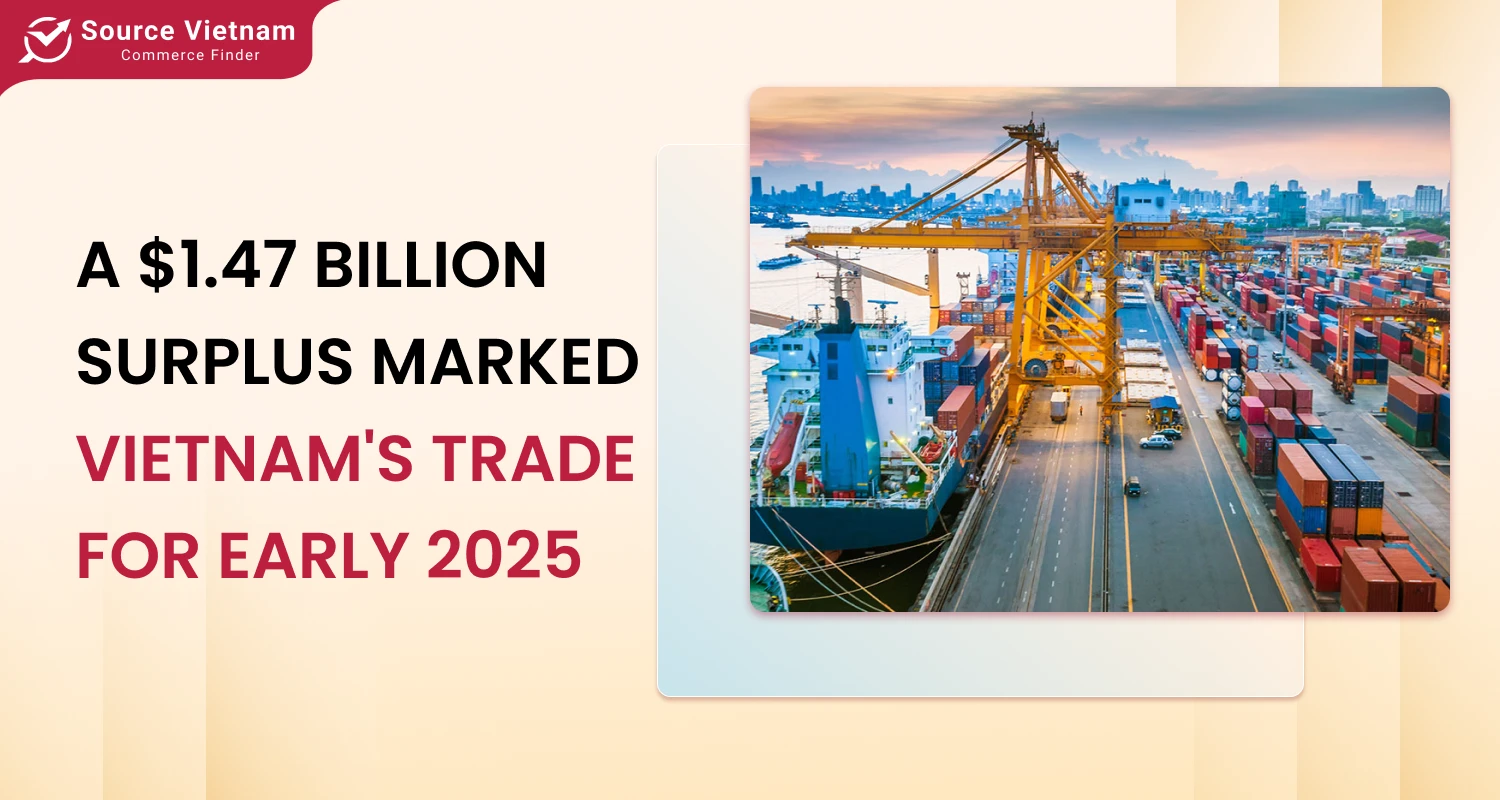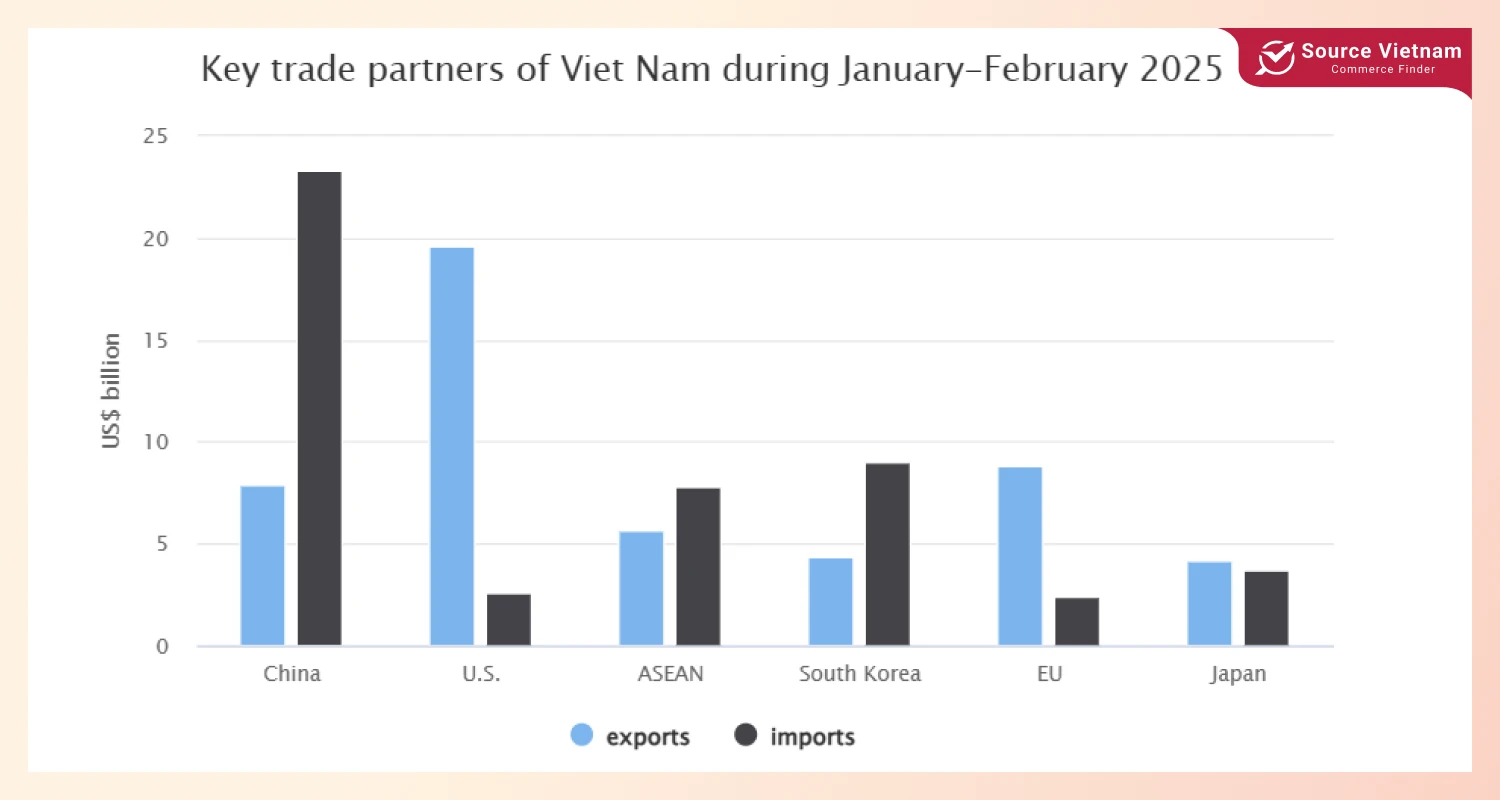Key takeaway:
- Vietnam’s early 2025 trade: strong growth, $1.47B surplus, driven by manufacturing.
- $1.47B surplus: Vietnam’s 2025 trade booms with rising exports and imports.
- Vietnam sees a $1.47B trade surplus, signaling strong 2025 manufacturing growth.
- Early 2025: Vietnam’s trade surges, achieving a $1.47B surplus.
- Manufacturing fuels Vietnam’s $1.47B trade surplus in the first two 2025 months.

Vietnam’s trade performance in the first two months of 2025 showed impressive growth, with exports and imports rising significantly, resulting in a trade surplus of $1.47 billion. This positive development highlights the country’s strong economic momentum and increasing integration into global trade networks.
Robust growth in trade turnover
According to the General Statistics Office (GSO), Vietnam’s total trade turnover surged to $127.07 billion in January-February, marking a 12% year-on-year increase. This growth indicates a strong rebound in global demand and reflects Vietnam’s resilience in international commerce.
During this period, the country’s export revenue reached $64.27 billion, an 8.4% increase from the previous year, while import spending jumped by 15.9% to $62.8 billion. Despite the sharp rise in imports, Vietnam maintained a trade surplus, signaling strong competitiveness in key export sectors. This trade surplus strengthens investor confidence and positions Vietnam as a crucial player in global trade.

Export sector: Industrial goods lead the way
Vietnam’s exports continued to be driven by the foreign-invested sector, which contributed $46.35 billion, making up 72.1% of total exports. Meanwhile, the domestic industry, though smaller in scale, exhibited notable growth, generating $17.92 billion and accounting for 27.9% of the total.
Twelve export categories surpassed the $1 billion mark, accounting for 77.7% of the total export value. Four key items exceeded $5 billion, demonstrating the strength of Vietnam’s high-value industries.
The breakdown of key export groups is as follows:
- Processed industrial goods: $57.01 billion (88.7% of total exports)
- Agricultural and forestry products: $5.35 billion (8.3%)
- Seafood: $1.43 billion (2.2%)
- Fuel and mineral products: $0.48 billion (0.8%)
February’s export turnover stood at $31.11 billion, a 25.7% increase from the same month last year, despite a 6.2% decline compared to January. Notably, the domestic sector outpaced the foreign-invested sector in growth, with a 32.8% rise compared to the latter’s 23.2% increase.
Vietnam’s success in industrial exports reflects the continued shift towards high-value manufacturing and technology-driven industries. The government’s emphasis on fostering domestic innovation and attracting foreign direct investment (FDI) is fueling this transition, ensuring long-term growth for the export sector.
Imports surge as manufacturing expands
Vietnam’s import activity saw a substantial rise, reflecting increased demand for production inputs. The country spent $62.8 billion on imports, with the domestic sector contributing $22.8 billion (up 18.7%) and the foreign-invested sector accounting for $40 billion (up 14.4%).
Sixteen import categories exceeded $1 billion in value, representing 76.2% of total imports, while two items surpassed the $5 billion threshold, making up 44.5% of the total.
The composition of imports underscores Vietnam’s manufacturing-driven economy:
- Production materials: $58.83 billion (93.7% of total imports), including:
- Machinery, equipment, tools, and spare parts: 50.8%
- Raw materials, fuel, and supplies: 42.9%
- Consumer goods: $3.97 billion (6.3%)
The significant rise in imports suggests a ramp-up in industrial production, particularly electronics, textiles, and machinery. Many of these imports serve as inputs for Vietnam’s growing manufacturing sector, which continues to play a key role in global supply chains.
Key trade partners: The US leads in exports, China dominates imports

Vietnam’s export market continues to rely strongly on its key trading partners, particularly the United States, which has firmly established itself as Vietnam’s largest buyer. In the past year, the US imported an impressive $19.6 billion worth of Vietnamese goods, showcasing Vietnam’s significant role in supplying diverse products to American consumers.
On the other hand, China remains Vietnam’s primary source of imports, providing goods valued at $23.3 billion. China and Vietnam’s economies are closely linked. China supplies important parts and raw materials that Vietnam needs for its manufacturing. This support helps Vietnam grow its export-focused economy.
Vietnam recorded notable trade surpluses with major partners:
- US trade surplus: $17 billion (up 16.3%)
- EU trade surplus: $6.4 billion (up 19.2%)
- Japan trade surplus: $0.5 billion (a tenfold increase from 2024)
However, Vietnam continued to experience trade deficits with several key economies:
- China: $15.4 billion (up 36.9%)
- South Korea: $4.6 billion (up 20.6%)
- ASEAN nations: $2.1 billion (up 116.8%)
Vietnam’s strong trade relationship with the US and the EU stabilizes its economy. However, the increasing trade deficit with China and South Korea suggests a reliance on imported raw materials and components, making supply chain diversification a critical consideration for long-term economic stability.
What this means for Vietnam’s economy
Vietnam’s trade dynamics highlight both strengths and challenges. The country’s ability to sustain a trade surplus despite rising imports suggests strong global demand for its products, particularly in the industrial and agricultural sectors.
However, the growing trade deficit with China and other Asian economies signals a high dependence on imported materials and components. To reduce vulnerabilities, Vietnam may need to strengthen its domestic production capabilities and diversify its sources of raw materials.
Additionally, the sharp increase in imports indicates expanding industrial activities, a positive sign for long-term growth. Still, it is crucial to ensure that rising imports do not outpace export growth, which could pressure Vietnam’s trade balance in the future.
Outlook for the coming months
Vietnam’s trade prospects remain favorable, bolstered by strong export demand and robust manufacturing activity. However, global uncertainties, including geopolitical tensions and supply chain disruptions, could pose challenges. The government’s focus on trade diversification and investment in high-tech industries will be essential in sustaining long-term growth.
With a solid start in 2025, Vietnam is well-positioned to build on its trade success and continue expanding its presence in the global marketplace. Policymakers and businesses must navigate potential risks while capitalizing on emerging opportunities.
Strengthening supply chain resilience, enhancing domestic production capabilities, and fostering innovation will be key strategies in ensuring sustained economic expansion in the years ahead.
As Vietnam moves forward, its ability to leverage its competitive strengths while addressing economic challenges will determine its future success. The emphasis on industrial development, export growth, and trade diversification will be critical in shaping Vietnam’s position in the global economy.






